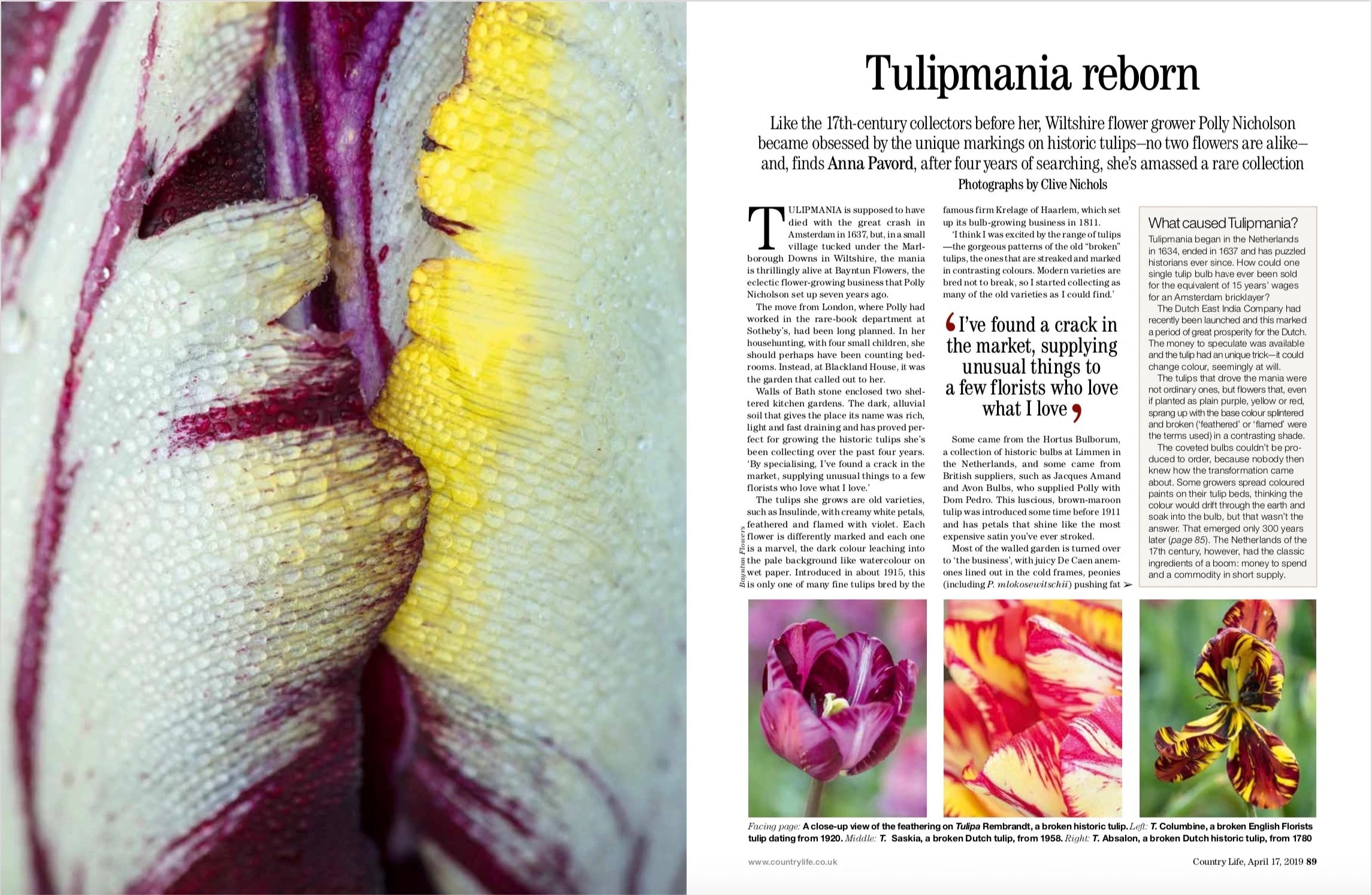Country Life | Tulipmania Reborn
Words by Anna Pavord
Photographs by Clive Nichols
Like the 17th-century collectors before her, Wiltshire flower grower Polly Nicholson became obsessed by the unique markings on historic tulips – no two flowers are alike – and, finds Anna Pavord, after four years of searching, she’s amassed a rare collection.
Facing page (left): A close-up view of the feathering on Tulipa Rembrandt, a broken historic tulip. Left: T. Columbine, a broken English Florists tulip dating from 1920. Middle: T. Saskia, a broken Dutch tulip, from 1958. Right: T. Absalon, a broken Dutch historic tulip, from 1780.
Tulipmania is supposed to have died with the great crash in Amsterdam in 1637, but, in a small village tucked under the Marlborough Downs in Wiltshire, the mania is thrillingly alive at Bayntun Flowers, the eclectic flower-growing business that Polly Nicholson set up seven years ago.
The move from London, where Polly had worked in the rare-book department at Sotheby’s, had been long planned. In her house hunting, with four small children, she should perhaps have been counting bedrooms. Instead, at Blackland House, it was the garden that called out to her.
Walls of Bath stone enclosed two sheltered kitchen gardens. The dark, alluvial soil that gives the place its name was rich, light and fast draining and has proved perfect for growing the historic tulips she’s been collecting over the past four years. ‘By specialising, I’ve found a crack in the market, supplying unusual things to a few florists who love what I love.’
The tulips she grows are old varieties, such as Insulinde, with creamy white petals, feathered and flamed with violet. Each flower is differently marked and each one is a marvel, the dark colour leaching into the pale background like watercolour on wet paper. Introduced in about 1915, this is only one of many fine tulips bred by the famous firm Krelage of Haarlem, which set up its bulb-growing business in 1811.
‘I think I was excited by the range of tulips —the gorgeous patterns of the old “broken” tulips, the ones that are streaked and marked in contrasting colours. Modern varieties are bred not to break, so I started collecting as many of the old varieties as I could find.’
Some came from the Hortus Bulborum, a collection of historic bulbs at Limmen in the netherlands, and some came from British suppliers, such as Jacques Amand and Avon Bulbs, who supplied polly with Dom pedro. This luscious, brown-maroon tulip was introduced some time before 1911 and has petals that shine like the most expensive satin you’ve ever stroked.
Most of the walled garden is turned over to ‘the business’, with juicy De Caen anemones lined out in the cold frames, peonies (including P. Mlokosewitschii) pushing fat snouts through the earth, teepees of hazel and willow waiting for their flowery shawls of sweet peas and rows of Thalictrum Elin.
However, the garden doesn’t look like a business. it looks gorgeous, immaculately maintained, the paths of South Cerney gravel freshly raked, the step-over apples around the beds perfectly pruned, the pieces of yew topiary as sharp as a steel engraving.
‘Yes,’ says Polly, ‘it does matter to me that it looks good.’ Without that single-minded perfectionism and the help of her team headed by Hannah Gardner, her head gardener, would she ever have been able to build up her extraordinary collection of old tulips, which has now spilled out of the gardens and into the park?
What caused Tulipmania?
Tulipmania began in the Netherlands in 1634, ended in 1637 and has puzzled historians ever since. How could one single tulip bulb have ever been sold for the equivalent of 15 years’ wages for an Amsterdam bricklayer?
The Dutch East India Company had recently been launched and this marked a period of great prosperity for the Dutch. The money to speculate was available and the tulip had a unique trick—it could change colour, seemingly at will.
The tulips that drove the mania were not ordinary ones, but flowers that, even if planted as plain purple, yellow or red, sprang up with the base colour splintered and broken (‘feathered’ or ‘flamed’ were the terms used) in a contrasting shade.
The coveted bulbs couldn’t be produced to order, because nobody then knew how the transformation came about. Some growers spread coloured paints on their tulip beds, thinking the colour would drift through the earth and soak into the bulb, but that wasn’t the answer. That emerged only 300 years later (page 85). The Netherlands of the 17th century, however, had the classic ingredients of a boom: money to spend and a commodity in short supply.
Clockwise from top: Le Mogol, 1913; Old Times, 1919; Rembrandt; Colum- bine,1920; Mabel, 1850- 1856. Facing page (right): Mabel.
Here, firmly fenced against deer and rabbits, is another half-acre of long, thin beds, planted with her treasures. She cuts at least 7,000 stems of tulips each year and has built up a superb collection of old varieties, such as Absalon, a rich mixture of brownish red, licked over with yellow, a type of tulip known among aficionados as a bizarre. Absalon has been grown since the end of the 18th century and Polly is one of a long line of growers who have been caught by its engrossing beauty.
Her historic tulips—including the pink - and - white Mabel, raised by John Martin in about 1860; James Wild, a rich brownish - red bizarre named after a Lancashire grower of the late 19th century; and soft-pink Rose des Dames introduced in about 1863 by Vincent van der Vinne of Haarlem—are left in the ground until July.
After that, the bulbs are lifted so that the offsets—the daughter bulbs that, each season, grow around the mother bulb—can be sorted and stored until planting time in late October. Polly’s aim is to become self-sufficient in bulbs—to have enough of her own flowering-size offsets each year to replenish her stock.
The growing season at Bayntun Flowers starts in March with narcissi such as W. P. Milner and finishes in November with a flurry of dahlias and chrysanthemums, but the tulips are her passion. ‘Such subtlety! Such beauty! And I love all the research that growing the old varieties has led me into. However much else I grow, it’s the tulips that excite me most.’
From a commercial point of view, however, Polly could scarcely have chosen anything trickier, as few tulips can be left simply to grow on their own. The bulbs need to be lifted and replanted each season, but that has become yet another reason to love them so much.
She is absorbed by the long process that growing tulips entails and was transfixed when one of her old English Florists’ tulips, Columbine, bred by Daniel Hall about 1920, first ‘broke’ from its plain lavender shades into a startling flower of white, feathered and flamed in the deepest purple. These are the ‘breaks’ that the tulip growers of the Netherlands waited for so eagerly and that drove the madness called tulipmania.
This April, the superb garden at Blackland House will be alight with 15,000 tulips in a celebration Polly has called Tulip Fever. Pride of place goes to the historic cultivars—there are now almost 50 in her collection—but there will also be species tulips in the borders, rows of dark Havran and La Belle Epoque in the walled garden and tulips in the park, where a herd of dark-fleeced Hebridean sheep gazes through the netting at fringed Blue Heron and the double early tulip Foxy Foxtrot.
Top Row, Left: T. James Wild, 1860, named after a 19th-century Lancashire grower. Middle: Dutch-bred T. Insulinde, 1915/16. Right: T. Le Mogo. Bottom Row, Left: T. Rose des Dames, 1863, bred by Vincent Van Der Vinne. Middle: T. Dom Pedro, 1911, shines like old satin. Right: T. Old Times
Meanwhile, Polly is planning ahead. Each year, she likes to have a project. Last year, it was tree planting in the park. This year, for the first time, she’s going to collect seed from some of her favourite tulips, sow it and see what comes up. it can take seven years for a tulip to grow from seed to flowering-size bulb, but Polly is undaunted. For her, tulips are worth any amount of waiting.
Polly Nicholson is hosting Tulip Fever at Bayntun Flowers, Blackland Park, Calne, Wiltshire, April 25–26 (10.30am–4.30pm), with florist Shane Connolly, writer of ‘The Tulip’ Anna Pavord, The Land Gardeners and Electric Daisy Flower Farm. £795, including lunches and dinner on April 25. For details, visit www.bayntunflowers.co.uk or email polly@bayntunflowers.co.uk.
Why do tulips ‘break’?
The answer to the mystery that frustrated. 17th-century tulip growers was finally unravelled in 1927 by Dorothy Cayley, a mycologist working at the John Innes Horticultural Institute. She discovered that the ‘breaks’ that produced the tulips so prized during tulipmania were caused by a virus spread by aphids.
Why did the answer not come sooner? The word virus wasn’t understood in the modern sense until the 1880s and the electron microscope, which enabled researchers to track the virus, did not appear until the 1920s.
Miss Cayley discovered that the effect of the virus was to partly suppress the laid-on colour of a tulip, its anthocyanin, leaving the underlying colour, always white or yellow, to show through. The tulip is the only example of a flower made more beautiful by a disease, but the mother bulb is weakened. As a result, it produces few offsets, hence the shortage of the essential commodity traded during the time of tulipmania.



